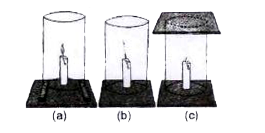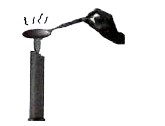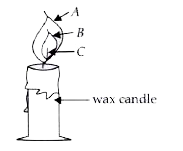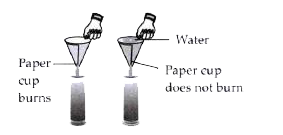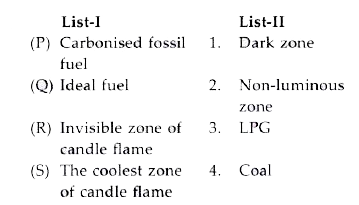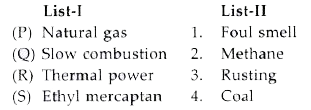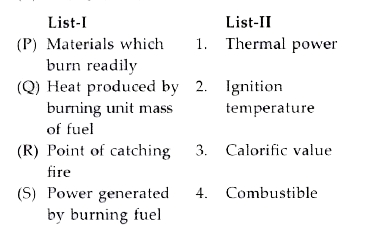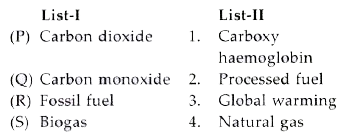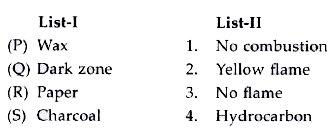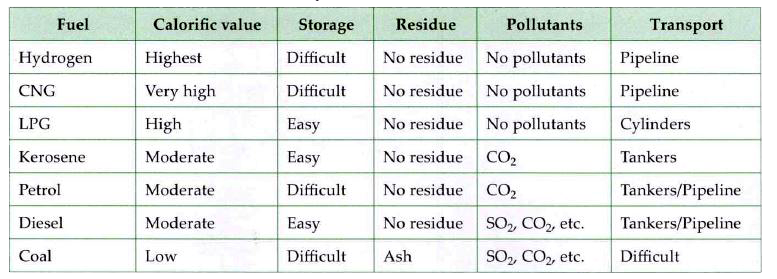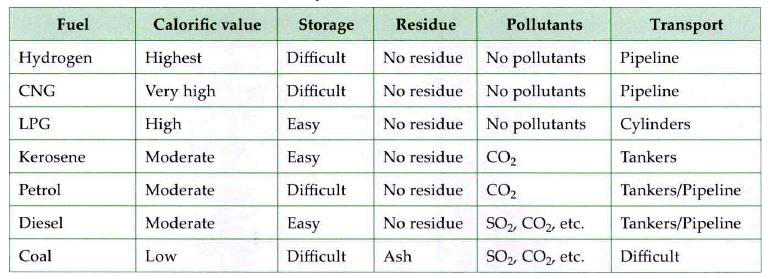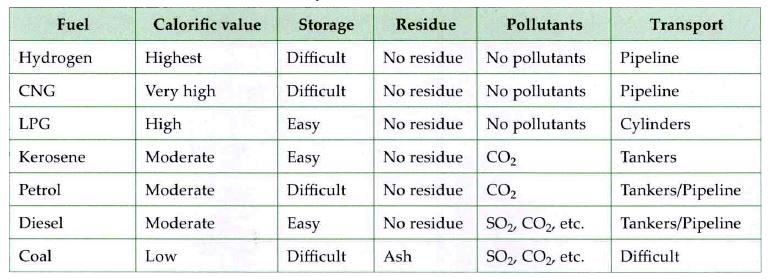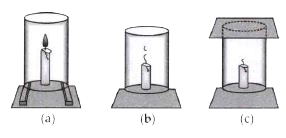EXERCISE (MULTIPLE CHOICE QUESTIONS) LEVEL 1 from MTG IIT JEE FOUNDATION COMBUSTION AND FLAME for Class 8
| Class 8 | CHEMISTRY |
| Chapter | COMBUSTION AND FLAME |
| MTG IIT JEE FOUNDATION | EXERCISE (MULTIPLE CHOICE QUESTIONS) LEVEL 1 |
| Medium | English |
| Academic Year | 2023-2024 |
Question 33
Read the following statements.
1. Water is the best extinguisher for fires involving inflammable materials
2. Carbon dioxide is used to extinguish fires involving oil and petrol
3. Water is not suitable for fires involving electrical equipments.
4. Fires caused by short-circuit should be immediately put off by sprinkling water on it.
Which alternative has the correct statementsView SolutionQuestion 46
Identify the correct statements.
(i) Carbon dioxide is used to extinguish fires involving oil and petrol.
(ii) Carbon dioxide used for extinguishing fires caused by oil.
(iii) Fires caused by short-circuit should not be put off by sprinkling water on it.
(iv) Water is not the best extinguisher for fires involving petrol and kerosene. View SolutionQuestion 47
Which of the following statements is/are correct?
I. The flame of a Bunsen burner is blue when the air hole is open and yellow when the air hole is closed.
II. The liquid or solid wax never catches fire.
III. A substance cannot catch fire if its temperature is higher than its ignition temperature.
IV. Water should be poured over burning petrol, kerosene or diesel.
V. The middle zone of a candle emits the least light View SolutionQuestion 66
When a combustible substance is burnt, it produces both light and heat, when heat energy that is produced by it is used, called fuel. Usually, fuels are compounds of carbon and hydrogen, thus they combine with oxygen on burning and liberate carbon dioxide and water vapour. Substances such as wood, coal, kerosene, diesel, petrol, LPG, etc., are commonly used as fuels. Fuels may be used at home, in industries and for transportation.
A fuel can exist in which of the following states? View SolutionQuestion 67
When a combustible substance is burnt, it produces both light and heat, when heat energy that is produced by it is used, called fuel. Usually, fuels are compounds of carbon and hydrogen, thus they combine with oxygen on burning and liberate carbon dioxide and water vapour. Substances such as wood, coal, kerosene, diesel, petrol, LPG, etc., are commonly used as fuels. Fuels may be used at home, in industries and for transportation.
Which of the following fuels is used for running automobiles?View SolutionQuestion 68
When a combustible substance is burnt, it produces both light and heat, when heat energy that is produced by it is used, called fuel. Usually, fuels are compounds of carbon and hydrogen, thus they combine with oxygen on burning and liberate carbon dioxide and water vapour. Substances such as wood, coal, kerosene, diesel, petrol, LPG, etc., are commonly used as fuels. Fuels may be used at home, in industries and for transportation.
Any substance may be regarded as a fuel which liberates carbon dioxide, water vapours and heat energy on reaction withView SolutionQuestion 69
Burning fuels such as diesel and coal release sulphur dioxide. It has corrosive effects and is also suffocative in nature. Acid rain is another serious problem which damages old monuments such as the Taj Mahal.
Oxides of nitrogen and sulphur are present in smoke emitted by vehicles. These combine with water vapour present in the atmosphere to form acids which are responsible for damaging soil, crops and buildings. This is the reason why the eco-friendly fuel CNG, is now being widely used in commercial vehicles, in India. The by-product of combustion of CNG is not harmful to the environment.
An ideal fuel is one which View SolutionQuestion 70
Burning fuels such as diesel and coal release sulphur dioxide. It has corrosive effects and is also suffocative in nature. Acid rain is another serious problem which damages old monuments such as the Taj Mahal.
Oxides of nitrogen and sulphur are present in smoke emitted by vehicles. These combine with water vapour present in the atmosphere to form acids which are responsible for damaging soil, crops and buildings. This is the reason why the eco-friendly fuel CNG, is now being widely used in commercial vehicles, in India. The by-product of combustion of CNG is not harmful to the environment.
How the pollution in the cities can be reduced by the use of CNG in automobiles?View SolutionQuestion 71
Burning fuels such as diesel and coal release sulphur dioxide. It has corrosive effects and is also suffocative in nature. Acid rain is another serious problem which damages old monuments such as the Taj Mahal.
Oxides of nitrogen and sulphur are present in smoke emitted by vehicles. These combine with water vapour present in the atmosphere to form acids which are responsible for damaging soil, crops and buildings. This is the reason why the eco-friendly fuel CNG, is now being widely used in commercial vehicles, in India. The by-product of combustion of CNG is not harmful to the environment.
Acid rain which is very harmful for crops, buildings and soils is formed by dissolvingView SolutionQuestion 75
Wax is a hydrocarbon. When the wick is lit, the solid wax melts and becomes a liquid. This liquid soaks into the wick and in the heat it is vaporized. The flame is a zone of combustion of these vapours of wax. When a candle burns, the carbon from the wax combines with oxygen in the air. Carbon undergoes oxidation, and gets changed into carbon dioxide. At the same time hydrogen combines with air to form water vapours. Some of the carbon does not burn and is deposited as soot.
The formation of soot occurs when View SolutionQuestion 76
Wax is a hydrocarbon. When the wick is lit, the solid wax melts and becomes a liquid. This liquid soaks into the wick and in the heat it is vaporized. The flame is a zone of combustion of these vapours of wax. When a candle burns, the carbon from the wax combines with oxygen in the air. Carbon undergoes oxidation, and gets changed into carbon dioxide. At the same time hydrogen combines with air to form water vapours. Some of the carbon does not burn and is deposited as soot.
Why does wax burn with a flame? View SolutionQuestion 77
Wax is a hydrocarbon. When the wick is lit, the solid wax melts and becomes a liquid. This liquid soaks into the wick and in the heat it is vaporized. The flame is a zone of combustion of these vapours of wax. When a candle burns, the carbon from the wax combines with oxygen in the air. Carbon undergoes oxidation, and gets changed into carbon dioxide. At the same time hydrogen combines with air to form water vapours. Some of the carbon does not burn and is deposited as soot.
The flame of the candle is View SolutionQuestion 111
Make a model of a fire extinguisher. Place a short candle and a slightly taller candle in a small dish filled with baking soda. Place the dish at the bottom of a large bowl. Light both the candles. Then pour vinegar into the dish of baking soda. Take care. Do not pour vinegar on the candles. Observe the foaming reaction. What happens to the candles? Why? In what order?
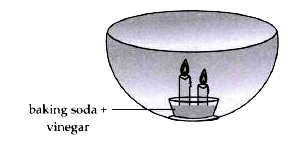 View Solution
View Solution
All Exercises from MTG IIT JEE FOUNDATION Class 8 CHEMISTRY COMBUSTION AND FLAME
- NCERT SECTION
- EXERCISE ( INTEGER/NUMERICAL/VALUE ) LEVEL 1
- EXERCISE (ASSERTION & REASON) LEVEL 1
- EXERCISE (COMPREHENSION) LEVEL 1
- EXERCISE (LONG ANSWER) LEVEL 1
- EXERCISE (MATCH THE FOLLOWING) LEVEL 1
- EXERCISE (MULTIPLE CHOICE QUESTIONS) LEVEL 1
- EXERCISE (SHORT ANSWER) LEVEL 1
- EXERCISE (VERY SHORT ANSWER) LEVEL 1
- OLYMPIAD/HOTS CORNER
- ILLUSTRATIONS
- SOLVED EXAMPLE



